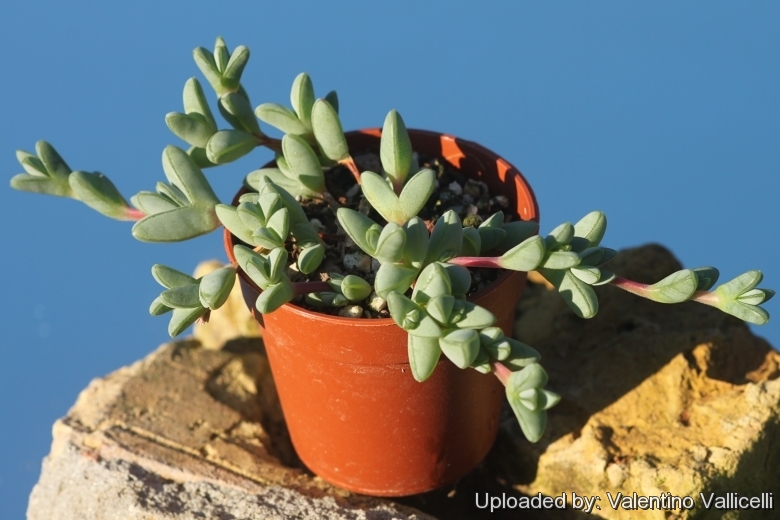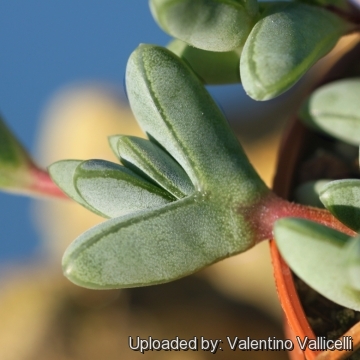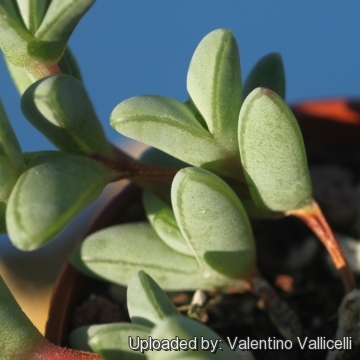Accepted Scientific Name: Braunsia maximiliani (Schltr. & A.Berger) Schwantes
Gartenwelt 32: 644 1928

Echinus maximiliani (Braunsia maximiliani) Photo by: Valentino Vallicelli
Origin and Habitat: Braunsia maximilianiSN|27453]]SN|27453]] occours only in the Clanwilliam, Piquetberg, and Vanrhynsdorp Districts, in the Western Cape and Northern Cape, South Africa.
Altitude range: 250 - 1100 metres above sea level.
Habitat and ecology: This species grows in shallow pans on rocks together with moss. Rainfall around 125 mm p.a. in winter.
Synonyms:
See all synonyms of Braunsia maximiliani
back
Accepted name in llifle Database:Braunsia maximiliani (Schltr. & A.Berger) SchwantesGartenwelt 32: 644 1928Synonymy: 7
back
Common Names include:
ENGLISH: Beads lampranthus
AFRIKAANS (Afrikaans): Kruipvygie
CHINESE (中文): 碧鱼莲
Description: Braunsia maximilianiSN|27453]]SN|27453]] sometimes known as Echinus maximilianiSN|27454]]SN|27454]] or Lampranthus maximilianiSN|27456]]SN|27456]] is a compact, creeping, perennial-succulent shrublet. It blooms early in the year with quite large rose coloured flowers.
Stems: Branches trailing and rooting at nodes, to 17 cm long, fertile branches erect, densely 4-leaved.
Leaves: Fused for a third of their length, trigonous, boat-shaped (with prominently convex sides) 6-10 mm long, 1,5-6 mm broad, 6-8 mm thick, grey-green, epidermis papillate and hence velvety to the touch over the entire surface, keel and margins white, cartilagenous.
Flowers: Solitary and terminal, pink, raised above the plant, 20-22 mm in diameter. Pedicels with bracteoles at their middle, petals bright pink, c. 10 mm long, 2 mm wide. Filamentous staminodes pink, filaments apically yellow or reddish, nectary ring crenulate.
*Fruit (capsules): Small, woody 5-locular, top completely flat, base elongate funnel-shaped, covering membranes complete, closing ledge only vaguely indicated, expanding keels extending to the tips of the valves when open.
*Seeds: Brown, testa cells big, raised in the centre like a hump, 0.67 mm long, 0.5 mm broad.
Blooming season: This species flowers in late winter (July—September).
Taxonomic notes: Braunsia maximilianiSN|27453]]SN|27453]] lacks the typical echinate seeds of genus Braunsia, this observation led L. Bolus (1965) to place this species in the genus Lampranthus, but the morphology of the flowers and leaves are typical for genus Braunsia, and the morphology of the capsules excludes this species from Lampranthus. In contrast to Lampranthus, where the expanding keels always diverge from the base, those of Braunsia are parallel for most of their length and only diverge towards the tips. The capsules of Lampranthus maximilianiSN|27456]]SN|27456]] were found to be typical of species of Braunsia in all these details. Well developed papillae on the leaf surfaces also support the latest placement of this species in Braunsia.
Bibliography: Major references and further lectures
1) Heidrun E.K. Hartmann “Illustrated Handbook of Succulent Plants: Aizoaceae A-E” Springer Science & Business Media, 06 November 2001
2) C. Klak “Taxonomic studies in the Aizoaceae from South Africa: three new species and some new combinations” Bothalia; Vol 30, No 1 (2000), 35-42.
3) African Plants Database (version 3.4.0). Conservatoire et Jardin botaniques de la Ville de Genève and South African National Biodiversity Institute, Pretoria, "Retrieved [8 November 2015]", from <http://www.ville-ge.ch/musinfo/bd/cjb/africa/>.
4) Burgoyne, P.M. 2006. Braunsia maximilianii (Schltr. & A.Berger) Schwantes. National Assessment: Red List of South African Plants version 2015.1. Accessed on 2015/11/10
5) Peter Goldblatt “Cape Plants: A Conspectus of the Cape Flora of South Africa” National Botanical Institute of South Africa, 2000
 Echinus maximiliani (Braunsia maximiliani) Photo by: Valentino Vallicelli
Echinus maximiliani (Braunsia maximiliani) Photo by: Valentino Vallicelli Echinus maximiliani (Braunsia maximiliani) Photo by: Valentino Vallicelli
Echinus maximiliani (Braunsia maximiliani) Photo by: Valentino VallicelliCultivation and Propagation: Braunsia maximilianiSN|27453]]SN|27453]] is a moderately slow growing pot subject, quite hardy with interesting leaf shapes. This species is easy to grow and clumps forming a beautiful succulent mat. Needs moderate water when growing in late fall and early spring. Keep somewhat dry the rest of the time. Like all living rocks, they thrive in porous soils with excellent drainage. It can tolerates high heat and some frost (hardy to -5° C or less if dry). It is a very rewarding succulent and can be cultivated in desert garden in warm climates or in greenhouses or windowsills in the home where too hardy. Enjoy bright shade in summer and full sun on the other seasons.
Propagation:: They grow quickly from seed or by division of larger clumps.












